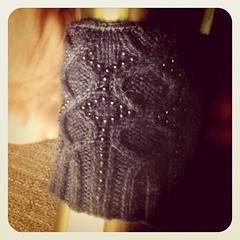Last year in March - only about three months into my knitting habit - I decided to try my hand at a really fiendish pair of gloves, Eisblume. This was sort of a symptom of my knitting disease: choosing patterns that are waaaaaaay too advanced for my skill level, which eventually just frustrate me and sit unfinished. Twisted stitches? Cables? Beaded stitches? All of these were skills I'd be learning along the way. But, I told myself, knitting techniques aren't hard - which is true. I've never met a knitting technique that actually seemed difficult after the first few times I did it.
It's a beautiful pattern, and gloves are the reason I decided I needed to learn to knit. My hands are too large for most commercially made gloves designed for women - too long - and men's gloves (which are sometimes long enough) are almost invariably too loose. Plus, gloves you can find in the men's section of most stores are boring. I don't need a pile of frills - I didn't need the cabled, beaded busyness of Eisblume - but a little embellishment or at least a little warmth is nice.
So I bought yarn and beads, and I cast on, and I started knitting. Before I even arrived at any cables or beads, though, the pattern held some new frustrations. I was working with a lighter weight of yarn than I'd ever worked with before - fingering weight, which is about half as thick as worsted weight, the stuff you usually see beginners using for scarves. The needles were thinner, too, only slightly thicker than toothpicks - 2.0mm, the US size 0. (Beginner scarves are usually on much thicker needles, more like chunky chopsticks.) Thin yarn on thin needles means a tight fabric, extra tight because of my own tendency to knit tightly. At such a tight gauge, the yarn fuzzed up in my fingers, and became difficult to slide along the needles.
When I did get to the beads (which started before the cables), that was a new adventure. There are a couple of methods for placing beads in knitted fabric. One involves simply stringing the beads on the yarn ahead of time, but this means that the beads sit sort of diagonally on only half of the knitted stitch (knit stitches are basically loops, and within fabric have two "legs" showing). The other involves placing the beads on the stitches as you come to them - usually using a crochet hook. But the beads I was using were too small for a crochet hook to go through, so instead I had to place them with a needle and thread.
Ordinary knit and purl stitches take me no time at all to work - maybe a second each. In a pattern that isn't easily memorized, reading the pattern slows that down some, but it's still a couple seconds per stitch at most. Account for the tight and slow-moving stitches, and I was moving pretty slowly. But each time I placed a bead on a stitch, that stitch took probably half a minute. Any given round, between beading and the tight stitches and juggling a cable needle (once those started) and just reading the pattern, was taking me about half an hour, and I felt like I was wrestling with the yarn and needles the whole time. I'd have to stop after an hour or so because I was frustrated and my hands would start to ache.
On gauge: you can swatch all you want in plain knits and purls, but there's no way of knowing that your gauge will translate to the gauge you'll get in a pattern with twisted stitches and cables and beads and things. There's no way to tell what your gauge will be like in pattern other than to try the pattern, and you need a good couple inches of work to really tell anything at all. I got about three or four inches into the cuff pattern - which is a good length to check gauge - before I realized that my tight stitches meant that the glove was going to be too small for me to wear, or at least wear comfortably.
And that's about a month of work.
I could keep on with them and offer them as a gift to someone with smaller hands, and that's what I planned to do - eventually. I needed something pleasurable and simple to work on, so I turned to other projects and set the gloves aside.
And they sat for the last seven or eight months. Every time I finished a knitting project or thought about starting something new, I'd look at them and consider working on them, but the thought was always fleeting. It's just too frustrating to wrestle that hard with a project that goes that slowly, knowing I won't be able to enjoy the end result myself.
I admitted my frustrations to Sam recently, and his response was immediate. "Bind it off," he said. "Let it be a cup cozy." He's done exactly that - bound off the first of a pair of Cookie A socks that he just wasn't connecting with (and was incidentally also turning out too small). His steel water bottle wears the cuff part, now.
So tonight, I did just that. I carefully bound off all the stitches, wove in the ends, and now the Eisblume cuff is a water bottle cozy. I'm glad I did it; I don't feel a pang of guilt every time I get an urge to knit something and I don't choose to work on them. Unravelling it after all that work and investment and frustration would have made me sad - this way I can still enjoy it. It is, after all, still gorgeous:
And that's all she wrote. Sam continues to teach me stuff about knitting that really isn't about knitting at all.
Like, you know, stop knitting stuff that makes you miserable.
Smart guy.

